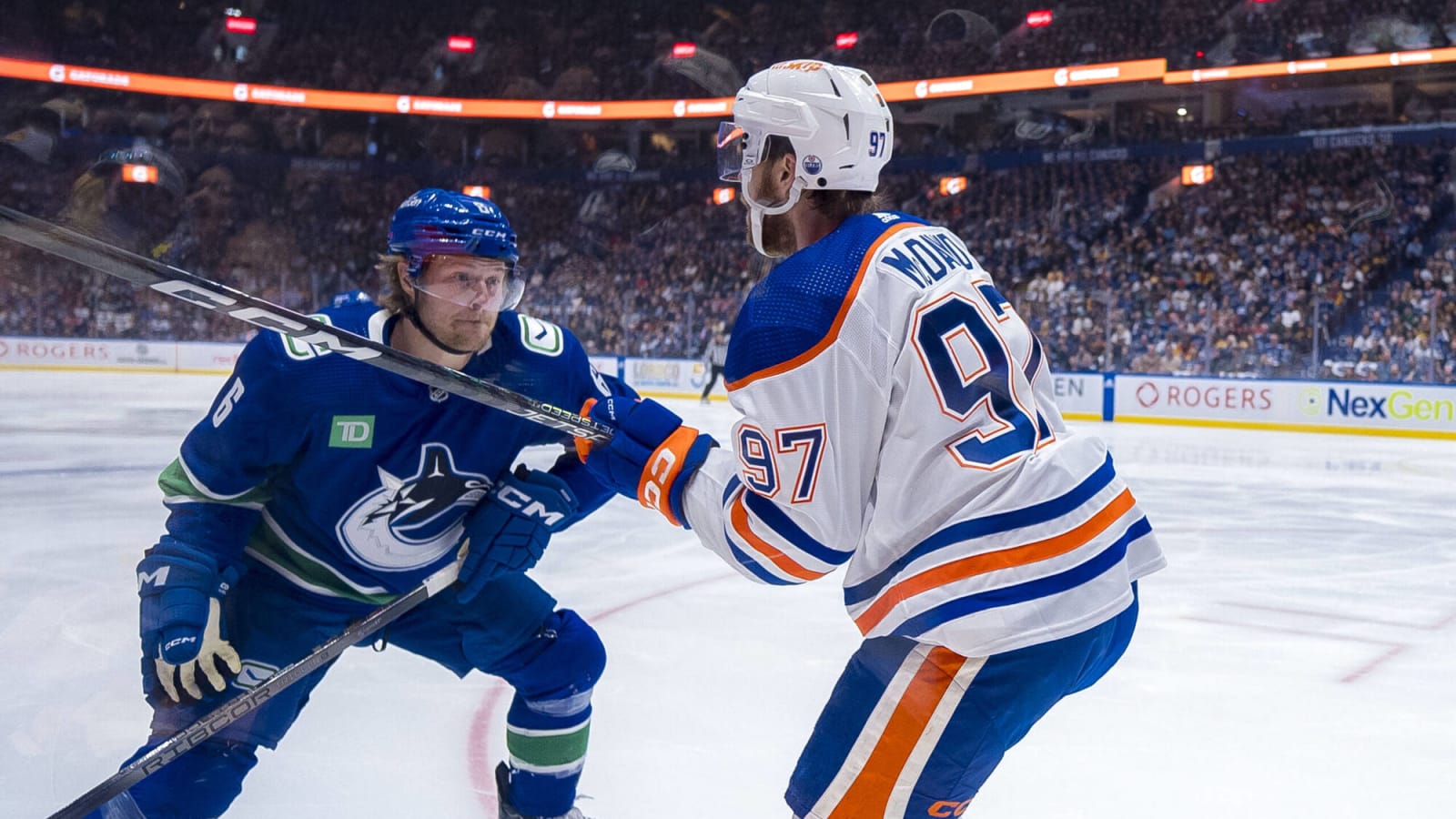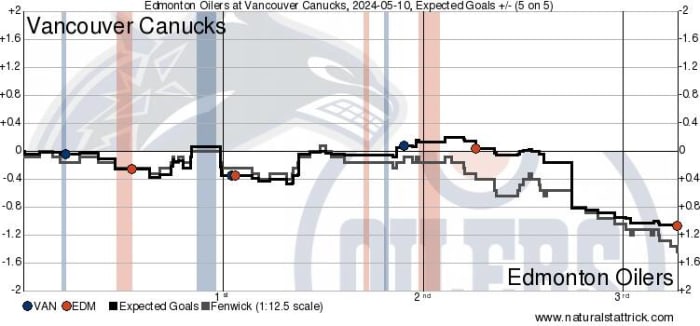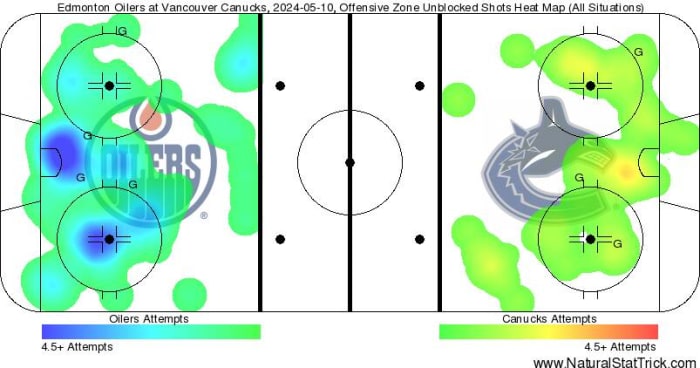
Welp.
The refs when the Canucks are about to win this game against the Oilers. #Canucks #EDMvsVAN pic.twitter.com/HQcqMmJmJ9
— BerubeSzn (@leafotter67) May 11, 2024
The Vancouver Canucks dropped a 4-3 overtime loss to the Edmonton Oilers in a game where they probably deserved to lose. Yes, the reffing didn’t help with matters, but at the same time, the Canucks found out what it’s like to be playing against an engaged McDavid and Draisaitl. The Oilers rode their top line and top pairing hard and got plenty of chances and momentum as a result. Vancouver could only hang on when they were on the ice, but in the time that McDrai wasn’t on the ice, the Canucks couldn’t capitalize on their other matchups. That inability to take advantage of weaker opposition proved costly in the end.
Here’s the loss, by the numbers.
As always, you can find our glossary guide of advanced stats here.
Game Flow

Unlike Game 1, the Canucks were not very good territorially in Game 2. In the first period, Vancouver registered 30.00 CF% and in the third, they finished off with a 31.43 CF%. The second was the only period where the Canucks had a larger CF% share, and even then it was barely above the midline with a 52.38 CF%. Their xGF% shares for each period reflected the possession that they had as a result. In the first, the Canucks’ xGF% stood at 38.94, while the second period saw that jump to 73.01. The third, however, was where Vancouver recorded 11.74 xGF%, giving up a 1-7 high-danger chance differential to close out regulation. Until that point, the Canucks did a decent enough job at 5v5 to hold the Oilers to just 5 HDCF, all recorded in the first period.
Heat Map

Most of Edmonton’s advantage in scoring chances came from their efforts in the first and third. The Oilers doubled up on the Canucks in total scoring chances by a 34-17 total, with a high-danger advantage of 16-6. The damage came from 14 chances in the first and 15 chances in the third, with 7 HDCF in the opening frame and 8 HDCF to close out the game across all situations. The second period was pretty much the only period where the Canucks were on even statistical footing as the Oilers, a 4-4 scoring chance differential with Vancouver having a 2-0 HDCF edge. Teams don’t tend to win hockey games just by playing a solid 20 minutes, and it shouldn’t really be a surprise that Edmonton eventually managed to find an equalizer and winner given the spread of play across the entire game.
Individual Advanced Stats
Corsi Champ: Nils Höglander has had a quiet playoffs thus far. In Game 2, he saw his ice time get reduced drastically as the only other Canuck to finish below 10 minutes of TOI was Sam Lafferty. Höglander did finish with the team’s best CF% of 78.57, primarily getting dragged along by Elias Pettersson’s resurgence. When he was on the ice, the Canucks out-shot the Oilers 8-1, with Höglander producing a team-best 0.13 xGA. It’s clear that the Swedish winger is pressing a little, unable to find a groove and bobbling routine plays. It might be worth seeing if another combination will spring him to life, or find Höglander a more effective role to fill.
Hoglander's effort can't be questioned but he's been having a real hard time making clean plays in the playoffs
— Satiar Shah (@SatiarShah) May 11, 2024
Corsi Chump: I mean, this is expected given the kind of game McDavid had. JT Miller finished as the team’s worst Corsi man with a 17.14 CF% on matchup duties, getting dummied by the Oilers’ top line analytically. The shots were 3-14, the scoring chances 3-12, high-danger chances 3-6. Miller recorded the fourth-worst xGA of 1.26 on the team and was generally hanging on as McDavid took flight in Game 2. The interesting part isn’t that though – it was clear that the Oilers’ top guns were riding hot. What is possibly flying under the radar is that despite conceding a lot of chances and territory, McDavid was still unable to score against JT Miller at 5v5.
“The problem is we didn’t play well in the offensive zone. We made it very easy on them.”
-JT Miller#Canucks— David Quadrelli (@QuadrelliD) May 11, 2024
xGF: Quinn Hughes deserves the Norris Trophy. Finishing with a 76.53 xGF%, the defenceman also recorded a team-high 1.02 xGF, on ice for a 10-3 scoring chance differential and not facing a single high-danger chance against with 4 HDCF going Vancouver’s way. Hughes was definitely deployed to try and capitalize on the Oilers’ lack of depth, but something else that stood out was that in his 5:15 of ice time against McDavid, he didn’t face a single high-danger chance against with only 2 scoring chances total in that span. That isn’t bad at all, considering how dangerous they looked and how much ice time Hyman-McDavid-Draisaitl saw in total.
Quinn Hughes recorded his 20th career assist in the #StanleyCup Playoffs and became the fastest player in @Canucks history to reach the mark.
Watch him now on @NHL_On_TNT (truTV), @SportsonMax, @Sportsnet, @TVASports, CBC. #NHLStats: https://t.co/eacyMW81wv pic.twitter.com/zlVjrxRy4X
— NHL Public Relations (@PR_NHL) May 11, 2024
GSAx: Arturs Silovs bounced back from a rougher Game 1 to produce a great effort in Game 2. Facing down 3.75 xGF, Silovs would finish the night with a -0.25 GSAx, but every goal that went past him couldn’t really be pinned on the Latvian’s shoulders. He came up with clutch saves and looked much more comfortable between the pipes, attacking shots where he could and controlling the rebounds that he punched out. Silovs gave up 2 high-danger goals and split the remaining two between middle and low-danger. He did his best against a heavy assault in the third, and was probably the biggest reason why the game even made it to overtime at all.
Arturs Silovs keeps this game tied with some clutch saves!#Canucks | #LetsGoOilers
️: Sportsnet | NHL pic.twitter.com/1IRfeEXeNl— CanucksArmy (@CanucksArmy) May 11, 2024
Statistical Musings
Lotto Line not winning the lottery: Here’s the thing when you stack Pettersson-Miller-Boeser – you expect them to help tilt the game in your favour. Last night, that was not the case. In the 3:19 that Tocchet iced them with the intention of sparking the momentum in Vancouver’s favour, the Lotto Line literally had a 0.00 CF%, facing down a 0.56 xGA which was the most of any line last night. Yes, in 3:19, they had more xGA than any other forward combination. The Lotto Line was hemmed in against the Oilers, giving up 6 scoring chances, of which 5 were recorded as high-danger. It isn’t good enough for your three best players to come up that empty at evens, especially when the opposition’s top guns were rolling as much as they were last night. The Lotto Line needs to help generate positive momentum for the Canucks instead of for the Oilers.
Not capitalizing on lesser matchups: This was mentioned previously, but looking across the board among the Canucks’ forward groups, they didn’t do nearly good enough against their opposition while Miller was occupying a dangerous McDavid. Take the Joshua-Lindholm-Garland line, who were so effective in Game 1. Against the same matchup in Game 2, they only recorded a 35.29 CF% while posting a tepid 19.91 xGF% without recording a single high-danger chance for. This was the same forward line that recorded 3 goals previously, so it is a stark contrast between that performance and this one. Where the Canucks have an edge against the Oilers is the fact that their lineup is deeper. There’s not going to be an answer to McDavid and Draisaitl on some nights, and that’s alright – not many teams have that kind of combination going for them. But Vancouver needs to take advantage of how Edmonton’s lineup thins out and when McDrai isn’t on the ice. Yes, they played nearly half the game – so what about the other half that they aren’t on the ice? The Canucks couldn’t capitalize on that, and unfortunately, that made a difference in Game 2.
Cole-Zadorov not working out: Ian Cole’s going to get a lot of flak after last night’s overtime winner (which went off Silovs’ skate and changed the angle just enough to bank off of Cole’s stick), which is understandable being on ice for 4 of 8 Oiler goals. But here’s the thing – both he and Nikita Zadorov haven’t been the greatest analytically as a pairing. The duo finished with the worst CF% (21.74) and xGF% (12.03) of any pairing last night while giving up 0.74 xGA and only registering 0.1 xGF, which seems strange given Zadorov’s been one of the Canucks most noticeable options defensively throughout the entire playoffs. It might be time to try out someone else besides Cole on that pairing – or shift them around in the lineup to reduce the veteran’s ice time a little.
The puck goes off Ian Cole's stick and into the back of the net.
This series is tied. pic.twitter.com/dbFRtu8kcO
— CanucksArmy (@CanucksArmy) May 11, 2024
As a team
CF% – 34.51% HDCF% – 27.27% xGF% – 32.79%
Reffing was bad, but there’s no denying that the better team won last night. Across nearly every category, the Oilers beat the Canucks and did so according to their blueprint – having McDavid and Draisaitl overwhelm the opposition darn near by themselves. That’s what they’re capable of and what they’ve been doing all playoffs. The Canucks didn’t do enough to take advantage of the Oilers’ weaknesses and it cost them a chance to go up 2-0 in the series. There are two ways of looking at this result though, depending on if you’re a glass half-full or half-empty person. If you’re half-empty, you look at this and see that the Canucks don’t have an answer to McDrai, which is true. You can only hope to stop them which isn’t a reliable strategy for winning in the playoffs, especially when you don’t have the last change. But, if you’re half-full, you see that McDrai played half the game and were rolling at their best – and yet, the Oilers still only got the win in overtime, and McDavid still couldn’t score against Miller at 5v5. Whichever is your perspective, one thing is an objective truth – this series is about to get very interesting if it hasn’t already.
Vancouver heads on the road for Game 3 in Edmonton to try and reclaim home-ice advantage.
Stats provided by naturalstattrick.com
More must-reads:
- Why Sheldon Keefe took Devils HC job so quickly
- New Jersey Devils to hire just-fired head coach to lead bench
- The 'Leading scorers from the 2003-04 NBA season' quiz
Breaking News
Customize Your Newsletter
 +
+
Get the latest news and rumors, customized to your favorite sports and teams. Emailed daily. Always free!

